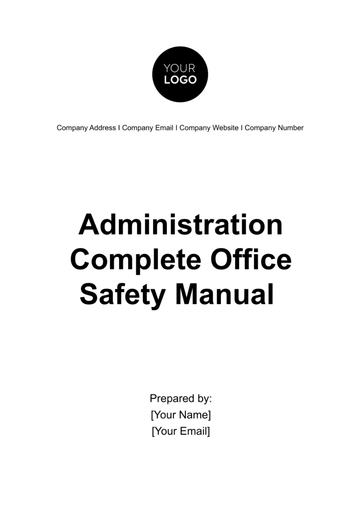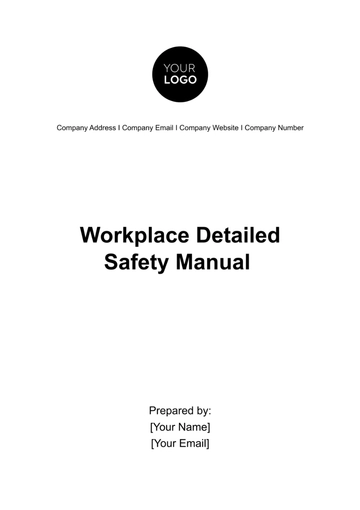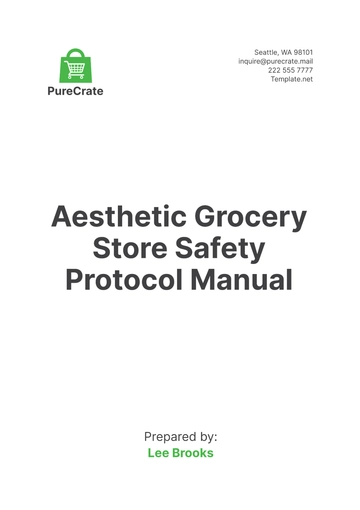Free Food Safety Manual

Name: | [YOUR NAME] |
|---|---|
Company Name: | [YOUR COMPANY NAME] |
Department: | [YOUR DEPARTMENT] |
Date: | [DATE] |
I. Introduction to Food Safety
At [YOUR COMPANY NAME], we place a high priority on maintaining the highest standards of food safety. Our commitment to these standards is vital for the health and safety of our customers. This manual sets out the guidelines we adhere to, in order to ensure food safety.
To meet our commitment to excellent food safety, each employee within our company, regardless of their role, needs to understand and adhere to our established food safety procedures. This manual will provide a comprehensive understanding of those procedures.
II. Food Safety Policies
In [YOUR COMPANY NAME], we have a set of strict safety policies that must be followed to ensure the well-being of our consumers. These policies are designed to minimize the potential for foodborne illnesses and other related problems.
Here is a breakdown of [YOUR COMPANY NAME]'s policies:
Adequate personal hygiene at all times.
Safe handling and storage of ingredients and products.
Regular cleaning and sanitizing of facilities and equipment.
III. Relevant Legislation
Food businesses must comply with a variety of local, national, and international regulations. At [YOUR COMPANY NAME], we abide by all relevant legislation in order to ensure we meet the highest food safety standards. This includes, but is not limited to [SPECIFIC LAW OR REGULATION 1], [SPECIFIC LAW OR REGULATION 2]
Failure to comply with these regulations can result not only in fines and penalties, it could also impact our reputation and, ultimately, the trust our customers place in us.
IV. Training and Education
It is crucial for all members of the [YOUR COMPANY NAME] team to have appropriate training in food safety. This training covers basic strategies to prevent foodborne illness, the correct techniques for preparing and handling food, and the correct procedures in case of an emergency.
All new employees will go through our comprehensive food safety training program. Existing employees take part in regular refresher courses and are updated on any changes to food safety regulations or company policies.
V. Roles and Responsibilities
While everyone at [YOUR COMPANY NAME] plays a part in ensuring food safety, certain roles come with specific responsibilities. This section outlines the food safety duties associated with each role in the company.
Roles included are [ROLE 1], [ROLE 2], [ROLE 3]
For inquiries please contact [YOUR COMPANY EMAIL] or [YOUR COMPANY NUMBER]
VI. Training and Education
Effective training and education programs are essential for ensuring that all employees understand and adhere to food safety protocols. Key components of our training and education initiatives include:
Orientation Training: Providing new employees with comprehensive training on food safety policies, procedures, and expectations.
Ongoing Training: Offering regular refresher courses and updates to ensure that employees stay current with food safety practices.
Certification Programs: Supporting employees in obtaining relevant certifications, such as food handling and safety certifications, to enhance their knowledge and skills.
VII. Incident Management
In the event of a food safety incident or emergency, swift and effective action is necessary to minimize harm and prevent further contamination. Our incident management procedures include:
Reporting: Establishing clear procedures for employees to report food safety incidents or concerns to management immediately.
Investigation: Conducting thorough investigations to determine the root cause of the incident and prevent future occurrences.
Communication: Keeping stakeholders informed about the incident and any actions taken to address it, including customers, suppliers, and regulatory authorities.
VIII. Supplier Management
Ensuring the safety of our products begins with the careful selection and management of our suppliers. Our supplier management procedures include:
Supplier Approval Process: Establishing criteria for evaluating and approving suppliers based on their food safety practices, quality standards, and compliance with regulations.
Supplier Audits: Conducting regular audits and inspections of suppliers to ensure compliance with our food safety requirements.
Traceability: Implementing systems to track and trace ingredients and materials back to their source to quickly identify and address any potential issues.
IX. Regulatory Compliance
Compliance with food safety regulations and standards is non-negotiable for [YOUR COMPANY NAME]. Our regulatory compliance procedures include:
Monitoring: Staying informed about changes and updates to food safety regulations at the local, national, and international levels.
Assessment: Conducting regular assessments and audits to ensure compliance with applicable regulations and standards.
Documentation: Maintaining thorough and accurate documentation to demonstrate compliance with regulatory requirements.
X. Continuous Improvement
Continuous improvement is central to [YOUR COMPANY NAME]'s approach to food safety. Our continuous improvement initiatives include:
Feedback Mechanisms: Encouraging employees to provide feedback and suggestions for improving food safety processes and procedures.
Performance Metrics: Establishing key performance indicators (KPIs) to measure and track food safety performance over time.
Review and Update: Regularly reviewing and updating food safety policies, procedures, and training materials to incorporate lessons learned and best practices.
VII. Conclusion
Congratulations! You have successfully completed the [YOUR COMPANY NAME] Process Manual Template. This comprehensive guide serves as a valuable resource for navigating the various processes and procedures within [YOUR DEPARTMENT]. By following the outlined protocols and best practices, you contribute to the overall efficiency and success of our organization.
Should you have any further questions or require assistance, please don't hesitate to reach out to [YOUR NAME] or the appropriate contact person. Thank you for your dedication and commitment to excellence!
- 100% Customizable, free editor
- Access 1 Million+ Templates, photo’s & graphics
- Download or share as a template
- Click and replace photos, graphics, text, backgrounds
- Resize, crop, AI write & more
- Access advanced editor
Introducing the Food Safety Manual Template from Template.net. Crafted for convenience, this editable and customizable resource ensures seamless adaptation to your specific needs. Effortlessly modify content with our Ai Editor Tool, empowering you to streamline food safety protocols with precision and efficiency. Simplify compliance today.





























